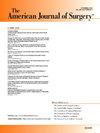在早期乳腺癌中,外科医生进行的术中导线定位与放射科医生进行的术前定位相比,边缘阳性率是否更低?
IF 2.7
3区 医学
Q1 SURGERY
引用次数: 0
摘要
背景:本研究比较了早期乳腺癌保乳手术(BCS)中两种定位技术的阳性边缘率:外科医生术中超声引导线定位(IOWL)与放射科医生术前线定位(POWL):方法:对在一家医疗机构接受BCS手术并进行随访的单灶乳腺癌患者进行回顾性鉴定。结果:177 名患者接受了 IOWL 术:177名患者接受了IOWL(85人)或POWL(92人)。IOWL与POWL相比,边缘阳性率明显较低(7.1% vs. 23.9%,p = 0.002),IOWL与POWL相比,再次切除率也相应较低(5.9% vs. 18.5%,p = 0.011)。DCIS的存在与边缘阳性相关(p = 0.015)。在对DCIS、肿瘤大小和切除组织量进行调整后,IOWL组的边缘阳性率明显低于POWL组(aOR 0.34, 95 % CI 0.13-0.93):在这项研究中,调整后的分析结果显示,IOWL更有利于实现肿瘤边缘阴性。需要进行前瞻性研究,进一步探讨 IOWL 对质量、成本效益和患者体验的影响。本文章由计算机程序翻译,如有差异,请以英文原文为准。

Does surgeon-performed intraoperative wire localization allow for lower margin positivity rates compared to radiologist-performed preoperative localization in early breast cancer?
Background
This study compares positive margin rates in breast conserving surgery (BCS) for early breast cancer using two localization techniques: surgeon-performed intraoperative ultrasound-guided wire localization (IOWL) versus radiologist-performed preoperative wire localization (POWL).
Methods
Patients with unifocal breast cancer undergoing BCS with follow-up at a single institution were retrospectively identified. Factors associated with positive margins were identified.
Results
177 patients underwent IOWL (N = 85) or POWL (N = 92). There was a significantly lower rate of positive margins for IOWL vs. POWL (7.1 % vs. 23.9 %, p = 0.002) and a corresponding lower rate of re-excision for IOWL vs. POWL (5.9 % vs. 18.5 %, p = 0.011). Presence of DCIS was associated with positive margins (p = 0.015). After adjusting for presence of DCIS, tumor size, and volume of tissue removed, the positive margin rate was significantly lower in the IOWL group compared to the POWL group (aOR 0.34, 95 % CI 0.13–0.93).
Conclusions
In this study, adjusted analysis favored IOWL in achieving negative tumor margins. Prospective studies are needed to further explore the impact of IOWL on quality, cost-effectiveness, and patient experience.
求助全文
通过发布文献求助,成功后即可免费获取论文全文。
去求助
来源期刊
CiteScore
5.00
自引率
6.70%
发文量
570
审稿时长
56 days
期刊介绍:
The American Journal of Surgery® is a peer-reviewed journal designed for the general surgeon who performs abdominal, cancer, vascular, head and neck, breast, colorectal, and other forms of surgery. AJS is the official journal of 7 major surgical societies* and publishes their official papers as well as independently submitted clinical studies, editorials, reviews, brief reports, correspondence and book reviews.

 求助内容:
求助内容: 应助结果提醒方式:
应助结果提醒方式:


